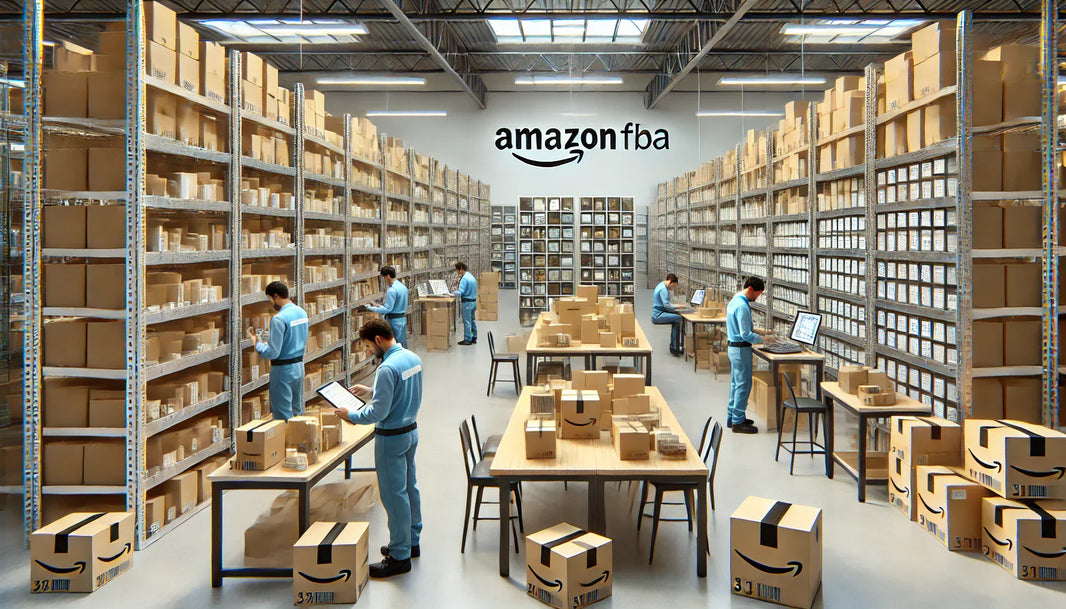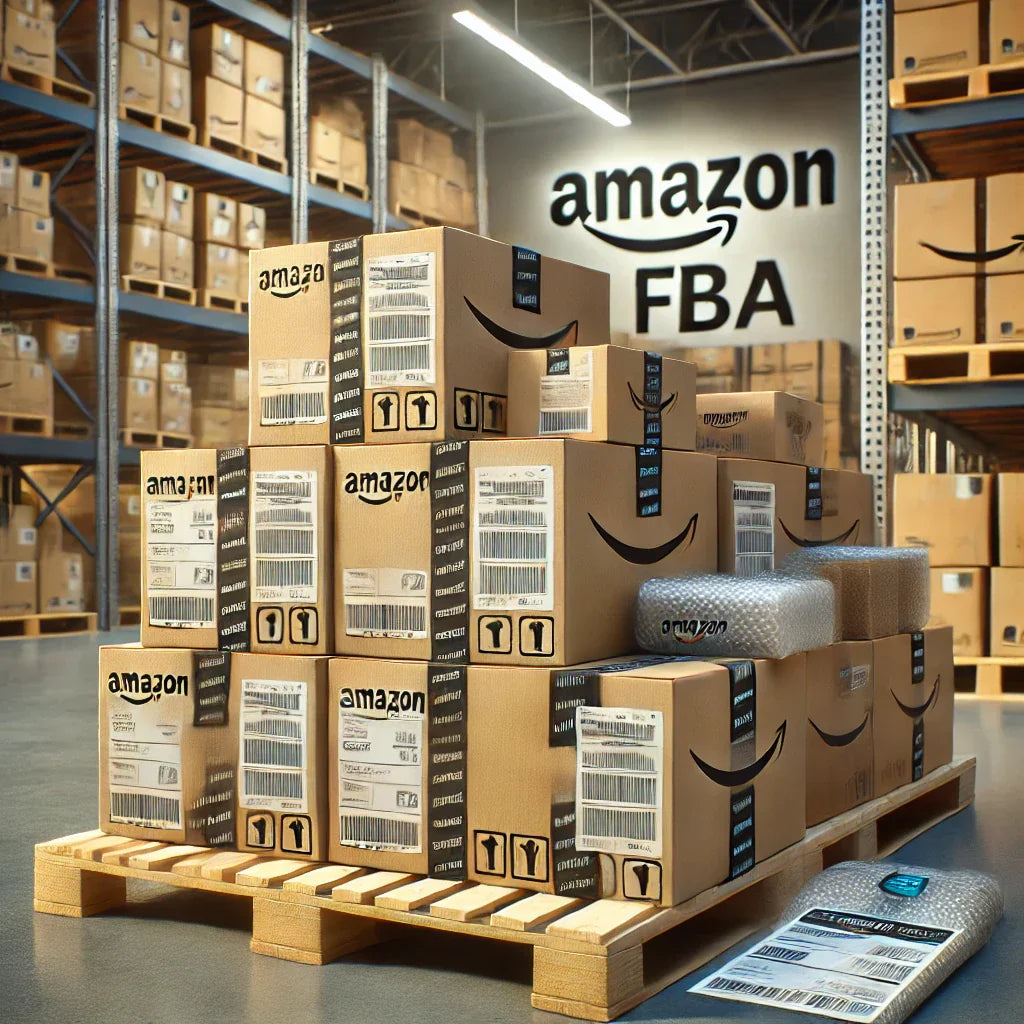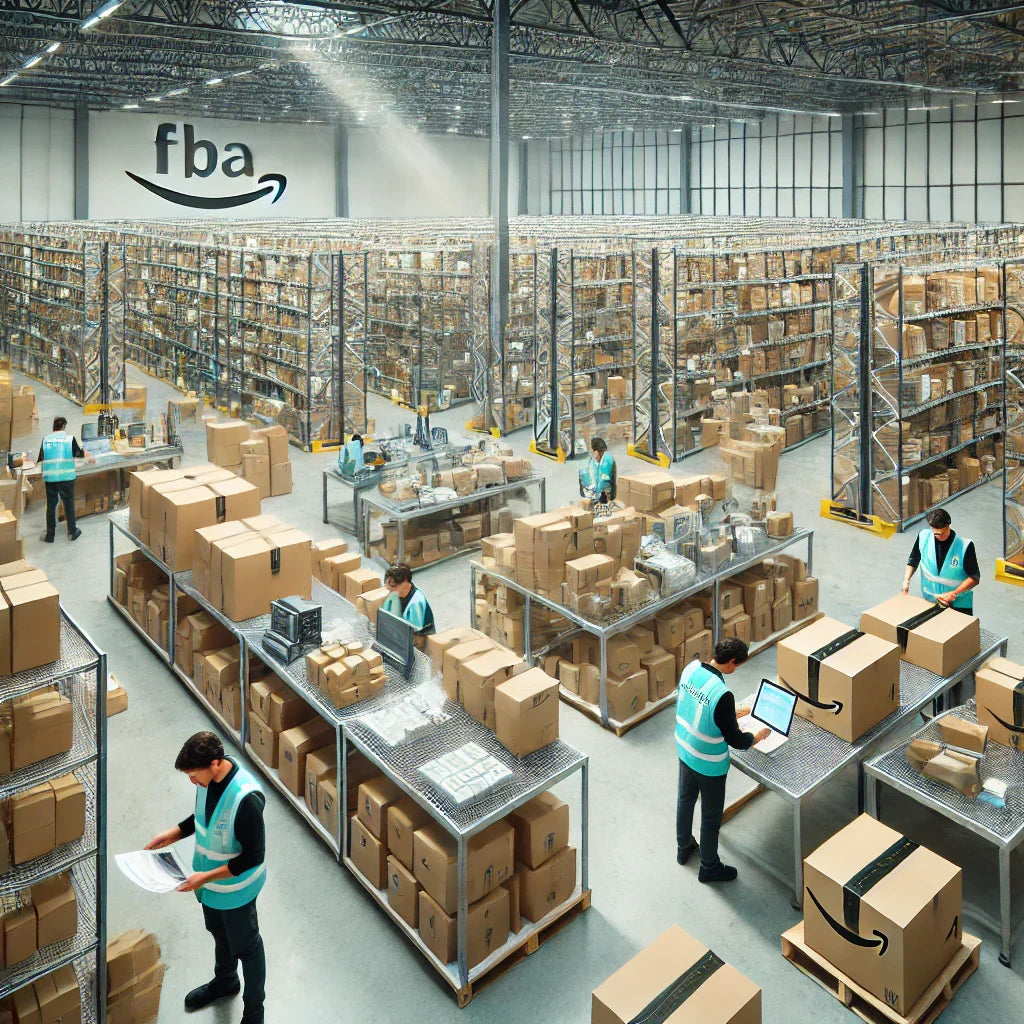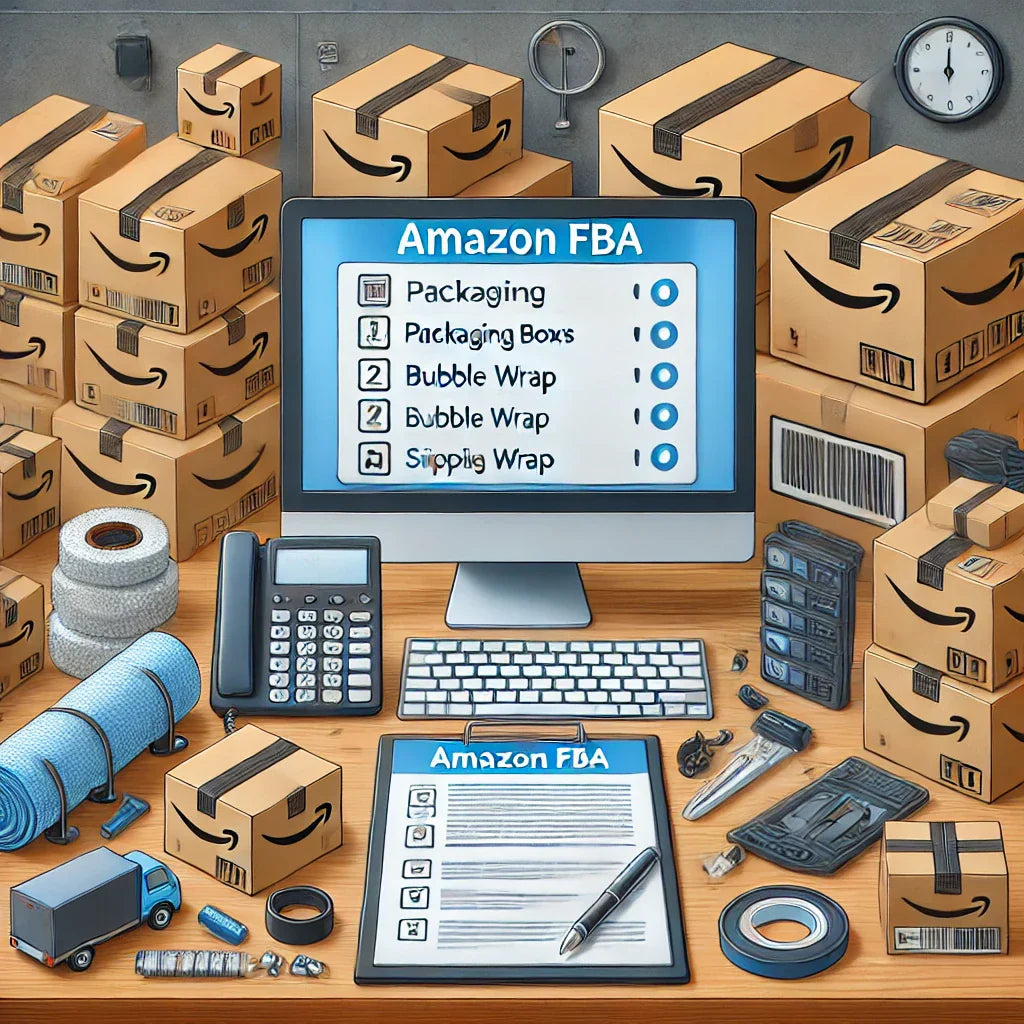In the fast-paced world of Amazon e-commerce, standing out among millions of sellers requires a well-planned and efficient approach to inbound logistics. One key component often overlooked is inbound preparation, a foundational step that can significantly impact a seller’s success on the platform. Proper inbound prep not only streamlines the fulfillment process but also minimizes errors, reduces costs, and enhances customer satisfaction. This article explores why mastering inbound prep is essential for Amazon sellers, detailing how it can bolster your operational efficiency, help you meet Amazon’s stringent requirements, and ultimately contribute to sustained growth and competitive advantage in an ever-evolving marketplace.

Understanding Amazon Inbound Prep: The Foundation of Successful Selling
Inbound preparation, or inbound prep, refers to all steps taken before your products are shipped to Amazon fulfillment centers. It encompasses tasks such as labeling, packaging, quality control, and ensuring compliance with Amazon’s guidelines. Amazon expects each seller to follow stringent inbound preparation protocols to streamline warehouse operations, maintain product quality, and meet customer expectations.
Amazon’s fulfillment process operates on efficiency, expecting sellers to provide accurate, well-organized, and properly prepped inventory. A well-structured inbound prep strategy helps prevent costly errors, such as rejected shipments or damaged goods, which could lead to negative reviews, customer dissatisfaction, and even account suspension. With the right approach to inbound prep, sellers are better positioned to thrive on Amazon's competitive platform.
The Role of Inbound Prep in Amazon's Fulfillment Process
Amazon’s fulfillment process is structured to deliver fast and reliable service to its customers. This system requires a steady, organized inflow of well-prepared products to ensure that Amazon can meet its delivery standards. The core of Amazon’s process is the Fulfillment by Amazon (FBA) program, where sellers leverage Amazon's fulfillment network, including warehousing, packing, and shipping.
Inbound prep is essential because it ensures that your products move smoothly through Amazon’s warehousing and shipping systems. Here’s why inbound prep plays a pivotal role:
- Warehouse Efficiency: Properly prepped inventory can be efficiently organized and stored, reducing Amazon’s handling time and costs.
- Faster Order Fulfillment: With accurate labeling and packaging, products can move through the fulfillment process more swiftly, meeting Amazon's fast delivery promises.
- Reduced Operational Costs: Errors in inbound prep lead to extra fees and penalties. Avoiding these ensures sellers maintain profit margins.
The more seamless your inbound preparation process, the better your chances of establishing a strong position as an Amazon seller.
Key Components of Effective Amazon Inbound Prep
Effective inbound prep consists of multiple components that collectively optimize your products for Amazon’s fulfillment process. Mastering these elements can boost Amazon seller success.
1. Product Labeling
Amazon requires each product to have a scannable label. This label allows for accurate tracking and management within Amazon's systems. Proper labeling practices include:
- Using FNSKU Labels: Each product must have an FNSKU (Fulfillment Network Stock Keeping Unit) label, a unique identifier in Amazon’s system. Sellers can generate these labels from their Seller Central account.
- Ensuring Clear Barcode Visibility: Labels must be placed in visible areas, avoiding edges or corners where they may fold or become difficult to scan.
- Checking Label Adherence and Quality: Labels should be durable and adhere well to the packaging. Poor label quality could cause issues during scanning, delaying the fulfillment process.
2. Packaging Standards
Amazon enforces strict packaging guidelines to maintain product quality. Improperly packaged items may be damaged in transit, negatively impacting your ratings and overall Amazon seller success.
- Protective Packaging: Fragile items must be carefully packaged to prevent breakage. Amazon may require specific packaging materials, such as bubble wrap or poly bags.
- Proper Sealing: All packages should be securely sealed to avoid tampering or spilling.
- Compliance with Hazmat Requirements: Products that contain hazardous materials must meet Amazon’s strict packaging standards to ensure safe storage and handling.
3. Inventory Inspection and Quality Control
Inbound prep includes a thorough quality control step to verify that products meet Amazon’s standards before they enter the fulfillment process. This step minimizes the risk of returns, negative feedback, and suspensions.
- Damage-Free Guarantee: Check for any signs of damage before shipping, as damaged goods can harm seller performance.
- Consistency in Product Quality: Products should match their Amazon listings in terms of color, size, and features, which is crucial to maintaining customer trust.
- Compliance with Product Guidelines: Certain items, like electronics or perishables, must comply with additional guidelines. Ensuring compliance ahead of time avoids costly errors.
Benefits of Effective Inbound Prep for Amazon Sellers
While Amazon inbound prep requires time and effort, the benefits are clear. Here’s how effective preparation can support your success as an Amazon seller.
1. Enhancing Customer Satisfaction
Inbound prep directly affects the customer experience. When items arrive on time, intact, and as described, customers are more likely to leave positive reviews, enhancing your seller rating. Amazon’s algorithm considers customer satisfaction, meaning better reviews can improve your visibility and sales potential on the platform.
2. Reducing Fulfillment Costs
Errors in inbound prep can lead to fines, extra handling fees, and even product returns. By ensuring compliance with Amazon’s standards, sellers can avoid these unnecessary costs. Furthermore, products that are correctly prepped enter the fulfillment process faster, reducing storage fees and improving cash flow.
3. Improving Inventory Turnover
Products that are promptly processed and listed increase inventory turnover rates. Higher turnover rates mean that products spend less time in Amazon’s warehouses, thus avoiding long-term storage fees and keeping your inventory dynamic and relevant.
4. Building Long-Term Amazon Seller Success
Establishing efficient inbound prep practices helps sellers consistently meet Amazon’s high standards, which can strengthen your account status, maintain healthy performance metrics, and enable you to build a reliable reputation. Long-term success on Amazon relies on consistent operational excellence, with inbound prep at the foundation.
Strategies for Streamlining Amazon Inbound Prep
For sellers looking to optimize their inbound prep process, the following strategies can help you avoid common pitfalls and improve efficiency.
1. Leverage Amazon's Prep Services
Amazon offers an optional prep service where they handle labeling, packaging, and compliance. While this service incurs additional fees, it can save time and ensure adherence to Amazon's standards, particularly for small or growing sellers who need to scale.
2. Develop a Standard Operating Procedure (SOP)
An SOP can help streamline inbound prep by documenting best practices and establishing repeatable steps. A clear SOP allows all team members to understand Amazon’s requirements, reducing errors and improving preparation speed.
3. Invest in Quality Control
Implement quality control at multiple stages, from product selection to final packaging. Quality control not only prevents errors but also enables sellers to catch potential issues before products reach Amazon’s warehouses, minimizing returns and customer complaints.
4. Use Technology to Improve Accuracy
Automate labeling, packaging, and inventory management where possible. Various tools integrate with Amazon’s Seller Central, providing inventory insights, label printing, and shipping tracking to improve efficiency.
5. Outsource to a Third-Party Logistics (3PL) Provider
Many experienced sellers use 3PL providers to handle inbound prep. 3PL providers specialize in fulfillment and can often ensure faster, compliant inbound prep. Partnering with a reliable 3PL can provide you with extra time to focus on other aspects of your business, such as marketing and product sourcing.

Avoiding Common Inbound Prep Mistakes on Amazon
Even seasoned sellers can make mistakes in inbound prep. Here are a few common errors to watch for, and tips on how to avoid them.
1. Incomplete Labeling
Labels must be complete and scannable. Ensure you use the correct FNSKU and place it where Amazon can scan it efficiently. Double-check labels before shipping to avoid delays.
2. Failing to Protect Fragile Items
Amazon’s warehouses are highly automated, so fragile items must be well-packaged. Bubble wrap, foam inserts, or specialized boxes can prevent breakage and keep products intact during fulfillment.
3. Ignoring Hazmat Regulations
Certain products, including batteries, chemicals, or electronics, require special packaging and documentation. Be sure to understand these regulations to avoid costly returns or account issues.
4. Overlooking Seasonal Demand
Peak seasons, such as holidays, require extra preparation. Plan your inbound prep to account for high demand, ensuring that products reach Amazon’s warehouses early to meet customer expectations.
Advanced Techniques to Optimize Amazon Inbound Prep for Maximum Efficiency
As sellers grow and gain experience on Amazon, they can begin to refine and enhance their inbound prep process through advanced strategies that promote even greater efficiency, reduce error rates, and improve their competitive edge. Here, we explore several techniques that go beyond basic preparation to help sellers streamline processes, enhance compliance, and achieve superior results.
1. Implementing Lean Principles in the Prep Process
Lean principles, often used in manufacturing, are designed to maximize efficiency and minimize waste. Applying these principles to your inbound prep process can help you achieve more with less effort and expense.
- Reducing Wasted Time: Streamline the steps between product receipt and final preparation. Set up an organized work area with designated spots for each prep stage to reduce time spent searching for labels or materials.
- Standardizing Repetitive Tasks: Use checklists or guidelines to standardize repetitive tasks like labeling and packaging. Standardization can reduce errors and improve consistency.
- Batch Processing: Group similar items together during prep, enabling efficient batch processing for labeling and packaging. For instance, handle all labeling in a single session to reduce setup time between different tasks.
2. Leveraging Data Analytics for Inbound Prep Optimization
Data analytics tools allow sellers to make informed decisions by analyzing past performance data, forecast demand, and refine inventory levels. Here’s how data can support a more efficient inbound prep strategy:
- Demand Forecasting: By analyzing past sales patterns, sellers can forecast demand for high-selling products, preparing sufficient stock and streamlining the inbound process during peak seasons.
- Identifying Bottlenecks: Analytics can help pinpoint where slowdowns occur in the inbound prep process, such as delays in labeling or frequent mistakes in packaging. Identifying and addressing these bottlenecks can improve throughput and overall efficiency.
- Inventory Planning: Accurate inventory tracking helps sellers maintain ideal stock levels, reducing both overstock costs and the risk of stockouts. With better insights, sellers can time their inbound shipments more effectively.
3. Cross-Training Team Members
Cross-training team members on various aspects of inbound prep, including quality control, labeling, and packaging, is an excellent strategy to ensure continuity and reduce bottlenecks.
- Enhanced Flexibility: Cross-trained employees can cover multiple roles during peak times, ensuring the process flows smoothly without interruptions.
- Quality and Efficiency: Cross-training can help team members understand the entire process, leading to fewer mistakes and higher-quality prep work as each team member is aware of how their tasks impact the final outcome.
- Employee Development: By offering skill-building opportunities, you can improve employee engagement and retention, which is beneficial for long-term operational efficiency.
4. Building Relationships with Suppliers for Quality Assurance
Successful inbound prep doesn’t start when products arrive at your warehouse; it begins with your suppliers. Working closely with suppliers can help ensure products arrive ready for seamless inbound prep, reducing the steps required before they reach Amazon’s fulfillment centers.
- Setting Quality Standards: Communicate clear quality expectations to suppliers to reduce the risk of receiving damaged or incomplete products.
- Requesting Supplier Labeling: Many suppliers can add FNSKU labels before shipping products to you, saving time and reducing costs on your end.
- Consistent Communication: Regularly engage with suppliers to address any recurring issues or seasonal adjustments in demand. Building a relationship based on open communication can improve inbound prep efficiency over time.
Essential Tools and Technologies to Enhance Amazon Inbound Prep
For Amazon sellers, efficiency is paramount, and technology can play a major role in streamlining inbound prep. Here are several tools and technologies that can significantly improve accuracy, reduce errors, and accelerate the inbound preparation process.
1. Inventory Management Software
Inventory management software helps sellers track stock levels, manage orders, and maintain oversight of incoming inventory. Popular software solutions include systems like InventoryLab, RestockPro, and Sellbrite, each offering unique features suited to different seller needs.
- Real-Time Stock Monitoring: Track stock levels to avoid stockouts and manage incoming shipments more effectively.
- Barcode Scanning Integration: Many inventory software tools support barcode scanning, making it easy to label items accurately and maintain proper records.
- Automated Reordering: Some software solutions can even automate reordering processes based on demand forecasts, ensuring that high-demand items are always in stock.
2. Label Printing and Scanning Tools
For sellers managing a high volume of products, efficient labeling is crucial. Label printing tools, like Dymo LabelWriter or Zebra printers, and scanning equipment can streamline labeling accuracy.
- Customized Label Printing: Print FNSKU labels in bulk for high-demand products, saving time during high-volume prep periods.
- Barcode Scanning: Scanning devices reduce human error during the labeling process and improve tracking accuracy.
- Mobile Labeling Apps: Some label printing systems offer mobile apps that allow you to generate and print labels from a mobile device, ideal for sellers with limited space.
3. Quality Control Apps
For quality checks, apps like Quality Control by Seller Central or EZTrackIt enable efficient tracking of product quality throughout the inbound prep process. These tools allow for more structured quality checks.
- Checklists and Tracking: Quality control apps can include checklists to standardize inspections, reducing the risk of missed steps.
- Digital Records: Store and access quality control records for each batch or product type, useful for identifying recurring issues.
- Reporting Capabilities: Quality control apps often include reporting tools that make it easier to analyze common errors and take preventive measures.
4. Project Management Software
Project management software like Trello, Asana, or Monday.com helps sellers manage complex workflows in the inbound prep process, especially when working with larger teams.
- Task Tracking: Keep track of each step in the inbound prep process, from inventory arrival to labeling, packaging, and quality control.
- Accountability: Assign responsibilities to team members and track task completion in real time, ensuring each product batch meets the standards.
- Progress Monitoring: Project management tools allow you to monitor overall progress, helping avoid delays or bottlenecks during peak seasons.
Case Studies: Success Stories in Amazon Inbound Prep
Learning from the experiences of other successful Amazon sellers can provide valuable insights into best practices for inbound prep. Here are two case studies that highlight how refined inbound prep strategies can drive seller success.
Case Study 1: Small Business Achieving Efficiency Through Automation
Business Profile: A small beauty products seller on Amazon.
Challenge: The business faced frequent delays and errors in its inbound prep, resulting in increased handling fees and customer dissatisfaction.
Solution: They implemented InventoryLab to track stock levels and Dymo LabelWriter printers to automate labeling. Quality control was improved by using digital checklists through Trello.
Outcome: The business saw a 30% improvement in inbound prep speed and a reduction in labeling errors, which helped them meet demand more effectively during the holiday season.
Case Study 2: Mid-Sized Electronics Seller Reducing Costs with Supplier Collaboration
Business Profile: A mid-sized electronics seller handling sensitive and fragile products.
Challenge: High costs associated with broken items and handling fees due to improper inbound prep.
Solution: They negotiated with their suppliers to pre-label products with FNSKU barcodes and improved packaging quality by adding bubble wrap and reinforced boxes. They also integrated their process with RestockPro to keep track of inventory.
Outcome: Reduced breakage by 40%, saved on labeling costs, and improved turnaround time, increasing customer satisfaction and profitability.

Seasonal Inbound Prep Adjustments for Amazon Sellers
For Amazon sellers, different times of the year may require adjustments in inbound prep to accommodate fluctuations in demand, new product releases, and holiday shopping seasons.
1. Preparing for High-Demand Seasons
During the holiday season, sellers need to be proactive about their inbound prep processes to meet increased demand and avoid stockouts. Preparing early can prevent logistical bottlenecks and ensure products are ready to ship.
- Advance Planning: Begin planning holiday stock several months in advance to account for increased demand and allow ample time for inbound prep.
- Extra Quality Checks: Conduct more thorough quality checks before high-demand seasons to avoid returns, which can be particularly costly and detrimental during peak times.
- Adjusting Inventory Levels: Use sales data from previous years to forecast holiday demand accurately and adjust inventory levels accordingly.
2. Managing Seasonal Products
If you sell seasonal items, such as holiday decorations or summer goods, prepare these products with dedicated inbound prep practices that ensure readiness before the season begins.
- Timing Inbound Shipments: Ensure that seasonal items arrive at Amazon’s warehouses before their peak demand period to capitalize on sales.
- Seasonal Packaging: Certain seasonal products may require unique packaging. For example, holiday items may benefit from special gift-ready packaging to enhance appeal.
- Marketing Alignment: Align inbound prep with your marketing plans. If a new seasonal promotion is set to go live, ensure inventory is prepared and available in Amazon warehouses to meet the anticipated increase in demand.
Monitoring and Improving the Inbound Prep Process Over Time
Effective inbound prep requires ongoing monitoring and improvement. Sellers who regularly evaluate their processes and make adjustments are better able to optimize their operations and ensure long-term Amazon seller success.
1. Conducting Regular Audits
Regular audits of your inbound prep process can uncover inefficiencies, errors, and areas where improvements can be made. Audits may focus on various aspects, including inventory tracking, label accuracy, packaging quality, and compliance with Amazon's guidelines. Here’s how to carry out an effective audit:
- Define Key Performance Indicators (KPIs): Set measurable benchmarks, such as error rates in labeling, time taken per product in prep, and costs per unit of packaging. KPIs provide tangible metrics to assess performance.
- Spot-Check Inventory: Periodically check batches of inventory to confirm that they meet quality standards before shipping. Random spot checks can reveal issues that may be overlooked during everyday prep.
- Review Supplier Compliance: Evaluate if suppliers are meeting their end of the agreement in providing properly labeled and packaged products. Supplier errors can lead to costly delays and should be addressed proactively.
Regular audits not only ensure compliance but also help identify bottlenecks or weaknesses that could impact the fulfillment process and customer satisfaction.
2. Incorporating Seller Feedback Loops
Amazon provides feedback mechanisms, such as seller performance metrics and customer reviews, that can help sellers identify strengths and weaknesses in their inbound prep.
- Customer Reviews: Carefully monitor customer reviews, especially those regarding product condition and packaging. Consistent complaints about packaging damage, for example, could indicate a need for sturdier packaging materials.
- Amazon Performance Metrics: Amazon evaluates each seller based on several performance metrics, including inventory performance, order defect rate, and late shipment rate. Reviewing these metrics can highlight inbound prep areas that need refinement.
- Feedback from Amazon Support: If Amazon flags any inbound shipments for compliance issues, use this feedback as a learning opportunity. Examine the reasons for rejection or delays to adjust and improve prep standards accordingly.
3. Using Data Analytics for Ongoing Improvement
Data analytics can help sellers track patterns over time, uncover trends, and understand which products require more intensive inbound prep. Analytics can also highlight seasonal demand changes and assist in adjusting inbound shipments accordingly.
- Trend Analysis: By analyzing monthly or quarterly data, sellers can identify trends that help plan for inventory and prep needs during specific times of the year, such as holiday peaks or off-seasons.
- Cost Tracking: Track costs associated with inbound prep to identify areas for savings. For example, certain packaging materials may be more expensive but could reduce damage-related returns, ultimately saving money.
- Improving Prep Time: By examining average prep times per product, sellers can spot efficiencies that lead to faster turnaround. Reducing prep time without sacrificing quality can free up resources and reduce costs.
4. Continuous Training and Development for Inbound Prep Teams
Ensuring that your team is well-trained and up-to-date on Amazon’s requirements is key to a smooth inbound prep process. Regular training sessions or workshops can help keep standards high.
- New Policy Training: Amazon’s guidelines may change over time, requiring sellers to stay updated. Schedule training sessions when Amazon releases new guidelines to ensure compliance.
- Skill-Building Sessions: Host workshops focused on specific skills, such as packaging fragile items, using barcode scanners, or managing labeling software. These sessions can improve prep accuracy and reduce errors.
- Incorporating Feedback into Training: Use insights from customer feedback, audits, and performance reviews to identify common issues and incorporate solutions into training sessions.
Regular training and continuous learning help create a knowledgeable team that can adapt quickly to Amazon’s standards, which is essential for long-term success.
Expanding Amazon Inbound Prep to Support International Markets
For sellers who expand to international Amazon markets, such as Amazon UK, Europe, or Asia, inbound prep becomes even more critical due to variations in compliance standards, logistics, and customer expectations.
1. Understanding International Compliance Standards
Each Amazon marketplace may have its own set of compliance standards, particularly regarding product labeling, packaging, and safety. For example, Amazon EU requires specific labeling for electrical products, while food items may require multilingual labels.
- Local Compliance Research: Research the regulations specific to each international marketplace and update your prep process to comply with each set of standards.
- Product Labeling and Translation: Ensure all labels, including FNSKUs, comply with local language requirements and accurately represent product details in that language.
- Third-Party Compliance Assistance: Consider hiring consultants or compliance experts who specialize in international markets to avoid issues with non-compliance.
2. Managing Shipping and Customs Requirements
Shipping internationally involves additional logistics, including customs documentation and import/export restrictions. Efficient inbound prep must account for these added layers.
- Customs Documentation: Ensure all required customs documents are prepared in advance, as missing documents can lead to delays or returned shipments.
- Adjusting Packaging for Longer Shipping Routes: Since international shipping takes longer, invest in more durable packaging to withstand the journey and protect product quality.
- Shipping and Duty Costs: Factor in the costs of duties, tariffs, and taxes for each international market, as these can impact your pricing strategy and profit margins.
3. International Inventory and Fulfillment Strategy
Amazon’s FBA program extends to several international markets, allowing sellers to store products in warehouses closer to target customers. Expanding inbound prep to these markets can enhance global reach and customer satisfaction.
- Local Warehousing: Use Amazon’s international warehouses to reduce shipping times and fulfill orders faster, enhancing customer satisfaction.
- Preparing Inventory for Each Market: Analyze demand in each market and adjust inventory levels accordingly. Seasonal trends vary by region, so forecast demand to align with local buying habits.
- Localization of Packaging: In some markets, local customers may expect or require certain packaging elements, such as eco-friendly or bilingual packaging. Adjusting your inbound prep to meet these expectations can improve the customer experience and build brand loyalty.

Sustainability in Amazon Inbound Prep: Meeting Eco-Friendly Expectations
As environmental consciousness grows, Amazon sellers are increasingly expected to adopt eco-friendly practices in their inbound prep. Sustainable inbound prep not only appeals to environmentally aware customers but may also reduce long-term costs.
1. Eco-Friendly Packaging Materials
One way to make inbound prep more sustainable is by using biodegradable or recyclable materials in packaging. This approach not only reduces waste but also improves brand perception among eco-conscious customers.
- Biodegradable Packing Peanuts and Bubble Wrap: Replace traditional plastic materials with biodegradable options, which can be safely disposed of by customers.
- Recyclable Boxes: Use corrugated cardboard boxes that can be recycled, helping to reduce environmental impact.
- Minimalist Packaging: Avoid excess packaging, which can reduce both costs and environmental impact. Amazon’s frustration-free packaging guidelines provide a helpful standard for minimal packaging.
2. Optimizing Shipping Efficiency to Reduce Carbon Footprint
Efficient inbound prep can help reduce carbon emissions by streamlining the shipping process. Consolidating shipments and minimizing handling steps contribute to a smaller environmental footprint.
- Consolidated Shipments: Instead of frequent, smaller shipments, plan for larger, less frequent shipments to reduce transportation emissions.
- Local Fulfillment Centers: Use Amazon’s fulfillment centers closest to your primary customer base, minimizing long-distance transportation requirements.
- Efficient Packaging Design: Design packaging that allows more products per shipment, reducing the number of boxes and packaging materials required per item.
3. Communicating Sustainability Efforts to Customers
Letting customers know about your eco-friendly inbound prep practices can boost brand loyalty and appeal to environmentally conscious buyers.
- Product Listings and Packaging Labels: Clearly state on product listings or packaging that eco-friendly materials were used, reinforcing your commitment to sustainability.
- Social Media and Branding: Share your sustainability efforts on social media platforms and in your branding materials. This not only enhances brand image but also sets you apart from competitors.
Scaling Inbound Prep as Your Amazon Business Grows
Growth brings new challenges, and scaling inbound prep is a necessary step for sellers who achieve increasing sales volumes. Here’s how to adapt inbound prep as your business expands.
1. Investing in Specialized Equipment
With higher product volumes, specialized equipment becomes invaluable for maintaining efficiency and accuracy in inbound prep.
- Automatic Label Printers: For high-volume labeling, invest in industrial-grade printers that can handle large label quantities quickly.
- Automated Sorting Machines: Sorting equipment helps with batch processing, allowing large product groups to be sorted by SKU or destination.
- Enhanced Quality Control Equipment: Invest in scanners and digital checklists that support quality control on a larger scale, reducing error rates and improving consistency.
2. Hiring and Training a Skilled Inbound Prep Team
An effective team is crucial as your inbound prep volume increases. This means hiring additional team members with expertise in Amazon’s fulfillment processes.
- Onboarding and Continuous Training: Train new hires in your SOPs and Amazon’s requirements to ensure they’re fully prepared to handle complex inbound prep tasks.
- Creating Specialized Roles: As your team grows, consider dividing responsibilities into specialized roles such as quality control, labeling, and packaging, each with dedicated team members.
- Leadership and Oversight: Appoint team leaders or supervisors to oversee the inbound prep process, ensuring accountability and efficiency.
3. Using a Third-Party Logistics (3PL) Provider
Outsourcing inbound prep to a 3PL provider can be an effective way to handle growing volumes. 3PL providers specialize in managing inventory, preparing products, and shipping to Amazon fulfillment centers, allowing you to focus on other areas of your business.
- Choosing a Reputable 3PL: Look for a 3PL provider experienced with Amazon FBA requirements to ensure compliance and efficient handling.
- Reducing Overhead Costs: Outsourcing can reduce costs related to warehousing, labor, and materials, especially when scaling to meet larger demand. This is particularly useful for sellers who want to avoid the costs associated with expanding their in-house facilities.
- Flexibility During Peak Seasons: A 3PL provider can adapt quickly to fluctuating demand, scaling resources up or down as needed during peak seasons, holidays, or promotional events. This adaptability ensures that inbound prep is managed efficiently without needing to make long-term internal adjustments.
- Enhanced Shipping Options: Many 3PLs have established networks with major shipping carriers, allowing for reduced shipping costs and quicker turnaround times. Faster delivery helps sellers maintain customer satisfaction and Amazon’s strict performance metrics.
Preparing for Amazon's Changing Policies and Trends in Inbound Prep
The Amazon marketplace constantly evolves, with new policies, trends, and best practices emerging regularly. Keeping up with these changes is essential for maintaining compliance and staying competitive. Here are some approaches to proactively adapt to Amazon’s dynamic environment.
1. Staying Updated on Policy Changes
Amazon periodically updates its policies on inbound prep, shipping requirements, packaging standards, and more. Ignoring these updates can lead to penalties, lost inventory, or even account suspension.
- Regular Review of Seller Central Announcements: Amazon publishes policy updates and new requirements on Seller Central. Setting a routine to check for updates weekly or monthly helps ensure your processes stay compliant.
- Amazon Webinars and Events: Amazon occasionally offers webinars and events focused on best practices, compliance, and updates. Participating in these events provides sellers with firsthand insights into upcoming changes.
- Networking with Seller Communities: Many Amazon seller forums and communities share experiences and advice on adapting to new policies. Engaging with these groups can offer practical solutions and tips from other sellers who have navigated recent changes.
2. Incorporating Amazon's AI and Machine Learning Tools
As Amazon’s fulfillment process evolves, AI and machine learning play an increasingly prominent role, especially in inventory management and demand forecasting. Leveraging Amazon’s tools can help sellers optimize inbound prep and stay competitive.
- Automated Restocking Recommendations: Amazon provides restocking recommendations based on sales data, trends, and seasonality. Following these insights helps ensure that inbound prep aligns with expected demand, preventing stockouts or overstock.
- Predictive Analytics for Inventory: Amazon’s machine learning tools can provide insights into buying patterns, helping sellers forecast demand and adjust inbound shipments accordingly. Accurate demand prediction streamlines inbound prep, ensuring that inventory levels are always optimized.
- Streamlining FBA with Automated Tools: Amazon’s tools help automate routine tasks like labeling and inventory tracking. Sellers can take advantage of these to reduce manual work and improve accuracy.
3. Embracing Sustainability Initiatives Aligned with Amazon’s Goals
Amazon has committed to various sustainability initiatives, and sellers who adopt similar practices may find favor in the marketplace. Sustainability is not only a growing trend but also a practical approach for attracting eco-conscious consumers.
- Frustration-Free Packaging: Amazon’s frustration-free packaging program emphasizes minimal, recyclable packaging. Sellers who participate in this program can gain an eco-friendly badge, improving product appeal to consumers who prioritize sustainability.
- Eco-Friendly Product Sourcing: Consider sourcing products with sustainable materials or choosing items that align with environmental standards. Products aligned with Amazon’s sustainability goals can enhance your brand image and broaden your customer base.
- Tracking and Reducing Carbon Footprint: Implementing energy-efficient practices in your inbound prep operations—such as using energy-saving equipment or optimizing shipping routes—aligns with Amazon’s sustainability goals and may reduce operational costs in the long run.
Expanding Your Brand Through Enhanced Inbound Prep Practices
As inbound prep becomes more refined, sellers can leverage these improved processes to enhance their brand image, build loyalty, and expand customer reach. Here are some ways to amplify brand success through inbound prep.
1. Using Branding to Stand Out in Packaging
Distinctive and quality packaging can make a strong first impression on customers. Well-prepared, branded packaging reflects professionalism and care, encouraging positive reviews and repeat purchases.
- Custom Branded Packaging: Including brand elements on packaging, such as a logo or slogan, can reinforce brand identity and create a memorable unboxing experience.
- Insert Cards for Promotions: Include a card in each package with a thank-you note, product information, or a promotional offer. This small detail enhances customer experience and can lead to repeat sales.
- Encouraging Product Reviews: Packaging inserts that kindly ask for reviews (in line with Amazon’s review policies) can boost the number of positive reviews, contributing to better product rankings.
2. Creating a Seamless Customer Experience
Ensuring that customers receive items as described, in excellent condition, and on time can build trust and encourage loyalty. A refined inbound prep process is critical to achieving these goals.
- Consistent Quality Assurance: By standardizing quality control, sellers can ensure consistent product quality, minimizing the chances of customers receiving damaged or incorrect items.
- Timely Delivery: Streamlining inbound prep improves product turnover, ensuring that products are always available and reducing potential delivery delays, which can frustrate customers and harm seller ratings.
- Managing Returns Efficiently: Inbound prep should also consider returns, ensuring that products returned to inventory are checked for quality before resale. Efficient return handling can improve customer satisfaction and preserve product quality.
3. Leveraging Positive Reviews for Brand Growth
An optimized inbound prep process often leads to a better customer experience, which can translate to positive reviews. Positive feedback, in turn, improves product visibility, enhances customer trust, and attracts more potential buyers.
- Encouraging Honest Reviews: Consistently delivering quality products and timely shipments encourages satisfied customers to leave positive feedback naturally.
- Responding to Customer Feedback: Addressing customer reviews—both positive and constructive—demonstrates attentiveness to customer satisfaction. Consider revising inbound prep strategies based on recurring feedback to improve product quality and packaging.
- Building Reputation and Credibility: As positive reviews accumulate, they reinforce your brand’s credibility, making your products more attractive to new customers and driving long-term growth.

Final Thoughts: Achieving Amazon Seller Success with Inbound Prep
Effective inbound preparation is the key to successful selling on Amazon. By investing in thorough and compliant prep, you can enhance operational efficiency, reduce costs, and improve customer satisfaction. Inbound prep may seem tedious, but each step ensures that products enter Amazon’s fulfillment process smoothly, contributing to the reputation and long-term success of your business. As the Amazon marketplace continues to grow and evolve, sellers who prioritize robust inbound prep will have the advantage of consistency, quality, and reliability in a highly competitive environment.
Inbound prep may be a single aspect of the seller experience on Amazon, but its importance to Amazon seller success is undeniable. By refining and prioritizing your inbound prep strategy, you position your business for better performance, customer satisfaction, and sustained growth on the platform.
Conclusion: The Strategic Advantage of Mastering Amazon Inbound Prep
Effective inbound preparation is far more than just a set of logistical steps. For Amazon sellers, it is a foundational aspect that supports the entire business—from inventory management and customer satisfaction to cost savings and brand growth. By dedicating time and resources to refine inbound prep, sellers can ensure smoother operations, align with Amazon’s stringent requirements, and deliver a consistent, high-quality experience to customers.
As Amazon’s marketplace grows and becomes more competitive, sellers who prioritize inbound prep will be well-positioned to thrive. Through continuous improvement, strategic partnerships, and technological advancements, mastering inbound prep can yield significant advantages, ultimately contributing to greater visibility, improved customer loyalty, and sustainable business growth on Amazon’s global platform.
Read More
- The Essential Guide to Inbound Prep for Amazon Sellers
- How to Optimize Inbound Prep for Amazon: Best Practices and Tips
- Understanding Amazon's Inbound Prep Requirements: A Step-by-Step Guide
- Inbound Prep Services for Amazon FBA: What Sellers Need to Know
- Common Mistakes in Amazon Inbound Prep and How to Avoid Them
- Amazon Inbound Prep: Streamlining Your Process for Faster Fulfillment







